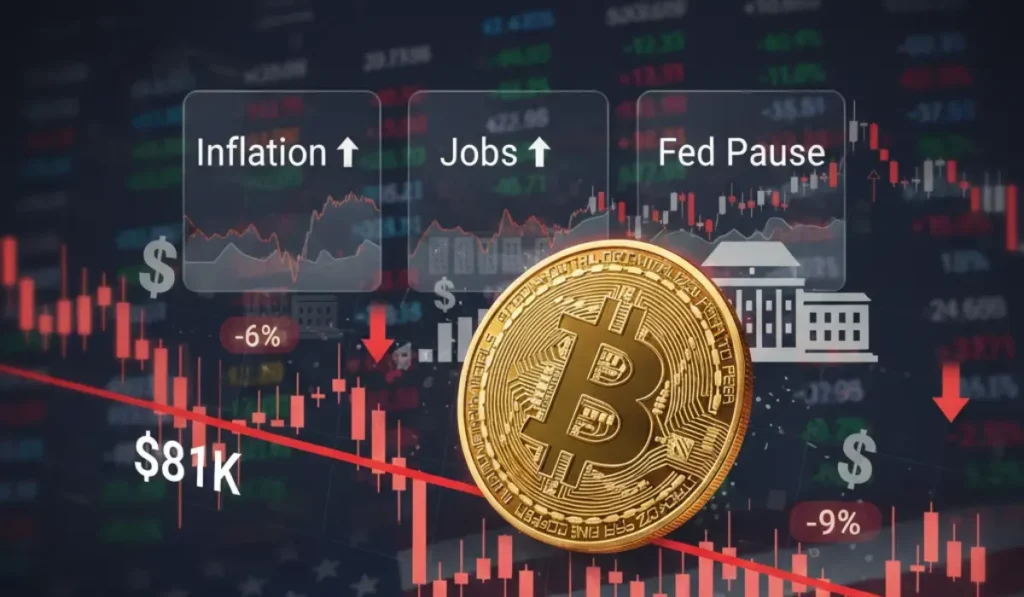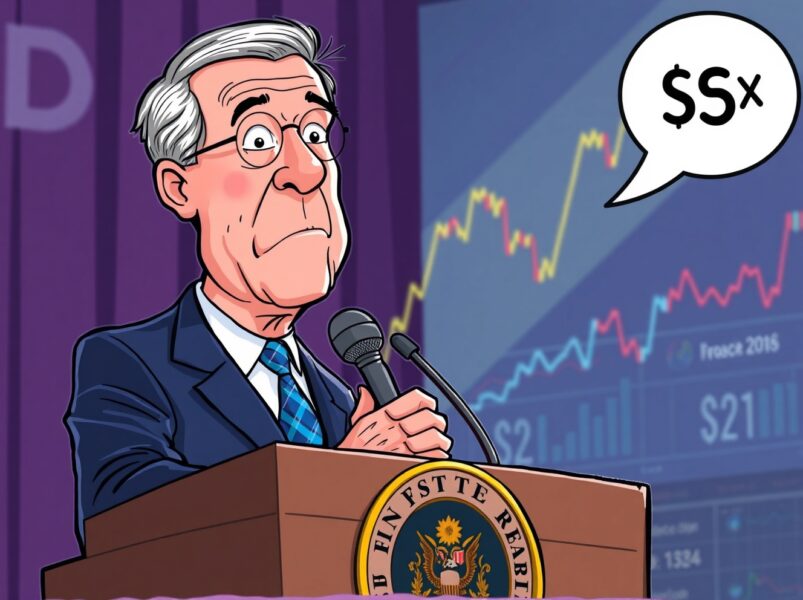Bitcoin Crash: Bitcoin Falls Below $81K as Strong Jobs Data, Inflation Weigh on Rate Cut Hopes
Key Takeaways
- BTC crashed by more than 10% in 24 hours to below $83,000 as September’s higher-than-expected inflation and job numbers could force the U.S. Federal Reserve to veto a rate cut in December.
- The Bureau of Labor Statistics (BLS) released the delayed September non-farm payroll numbers on Thursday, which showed that the U.S. economy added 119,000 jobs, beating Wall Street estimations. However, the unemployment number ticked up to 4.4%.
- The lack of comprehensive data supporting an economic boom has led the Federal Reserve to hit a pause in its rate-cut cycle. The central bank had cut its benchmark interest rate on the dollar by 25 bps in September and October.
- Over $900 million in crypto derivatives positions were liquidated in the last 24 hours, with more than 222,000 traders forced to exit the market. Meanwhile, U.S. spot bitcoin ETFs recorded their second-largest daily net outflow of $903.11 million on Thursday.
Bitcoin’s price fell below $83,000 early on Friday after the latest U.S. jobs report hinted at lingering inflationary pressures in the world’s largest economy. The apex crypto dropped more than 10% in the last 24 hours, hitting a six-month low.
BTC is now trading 33.72% below its all-time high of $126,198, which was recorded three days before the $19 billion liquidation event that rattled the broader crypto market in early October.
BTC Falls Below $81K as Rising Inflation and Job Data Signal Fed Pause
Kronos Research CIO, Vincent Liu, noted that the main catalyst behind bitcoin’s latest decline is the stronger-than-expected U.S. jobs and inflation data, which dampened expectations for an interest rate cut by the Federal Reserve in December. He noted that market liquidity remains thin, with profit-taking by short-term holders (STH) amplifying the downside move.
“The market is recalibrating risk, reacting to macro data points,” Liu added.

The September non-farm payroll data, released by the Bureau of Labor Statistics (BLS) on Thursday after being delayed by the record 44-day-long federal government shutdown, showed that the U.S. economy added 119,000 jobs in the month. According to CNBC, this number far exceeded the Dow Jones consensus estimate of 50,000.
While the headline jobs number is positive, the BLS noted that the unemployment rate edged higher to 4.4% – its highest level since October 2021. However, the broader unemployment measure, which includes individuals who are not looking for jobs or working part-time for economic reasons, edged lower to 8%.
Higher inflation and a lack of comprehensive positive economic indicators are fueling concerns that the Federal Reserve may pause its quantitative easing (QE) cycle. The central bank cut its benchmark interest rate on the U.S. dollar in both September and October, but it faces a tough decision next month.
During last month’s Federal Open Market Committee (FOMC) meeting, Fed governors noted difficulty in making a policy decision without being able to rely on the usual array of economic metrics due to the shutdown. According to the meeting minutes that were released on Wednesday, there was a significant inclination to forgo a December rate cut.
The CME Group’s FedWatch Tool currently gives a 35.4% chance that the central bank would cut rates by 25 basis points (bps) next month.
Liu said that while the markets are focused on the decision surrounding a December rate cut, much of it may have already been priced in. He expects bitcoin to bounce back if the Fed hits a break on quantitative tightening (QT), but a sustained rally would require fresh capital flows, strong on-chain demand, and a shift in investor sentiment.
Over $900M in Crypto Liquidated as Market Braces for Liquidity Tightening”
This macro uncertainty also sparked a massive liquidation event across major crypto exchanges. CoinGlass data shows that over $910 million in various crypto positions were liquidated over the last 24 hours, forcing 222,008 traders to exit the market.
Hourly long liquidation hit a peak of $264.79 million during early U.S. trading, while shorts peaked at $255.44 million. These forced closures highlight the significant leverage that’s present in the crypto market and how quickly those positions can unwind during a volatile period.
This cascade also revealed structural weaknesses in the crypto derivatives market. When BTC’s price dropped from above $91,000 on Wednesday to below $86,000 on Thursday, leveraged traders faced margin calls and had their positions closed automatically.
U.S. Spot Bitcoin ETFs See $903M Outflow, Second-Largest on Record
Meanwhile, the eight leading U.S. spot bitcoin exchange-traded funds (ETFs) reported a total daily net outflow of $903.11 million on Thursday, the second-largest daily exits since their debut nearly two years ago.
SoSoValue data shows that BlackRock’s IBIT, the world’s largest spot bitcoin ETF in terms of assets under management (AUM), saw $355.5 million in net outflows, while Grayscale’s GBTC and Fidelity’s FBTC saw $199.35 million and $190.4 million leave the funds. Ark & 21Shares’s ARKB ($94.42 million), Bitwise’s BITB ($21.17 million), VanEck’s HODL ($30.59 million), Franklin Templeton’s EZBC ($7.51 million), and Hashdex’s DEFI ($1.45 million) also posted losses.
Thursday’s numbers mark the highest net outflows experienced by the bitcoin-backed funds since February 25, when President Donald Trump’s surprise trade tariff announcement triggered a massive sell-off across the equity and crypto markets.
On a positive note, cumulative ETF inflows remain at $57.4 billion, while $8.92 billion in value has been traded by the funds as of November 20, 2025. The total net assets held by the ETFs stood at $113.02 billion, representing about 6.4% of the total BTC market cap.
Analysts Call Market Correction a ‘Healthy Repricing,’ See Bottom This Week
LVRG Research director Nick Rubin told crypto media outlet The Block that the ongoing market correction event is a “healthy repricing” of overextended positioning from last month’s price rally. He also noted that on-chain metrics indicate stabilizing spot and futures sell pressure, a signal of the capitulation being almost over.
While speaking to CNBC on Monday, Bitwise CIO Matt Hougan said that bitcoin’s price could bottom as soon as this week, claiming that current market conditions present a “generational opportunity” to accumulate BTC at discounted rates and are a gift for long-term investors.
At the time of writing, Bitcoin (BTC) is trading at $82,535 – down 9.79% in 24 hours.
Also Read: Coinbase Expands Crypto Credit with New ETH-backed Loans
The post Bitcoin Crash: Bitcoin Falls Below $81K as Strong Jobs Data, Inflation Weigh on Rate Cut Hopes appeared first on BiteMyCoin.
You May Also Like

Jerome Powell’s Press Conference: Crucial Insights Unveiled for the Market’s Future

Top 4 Cryptos That Could Spike in the Upcoming Altcoin Season

